|

On eBay Now...
1772 MASSACHUSETTS SPY w/ Paul Revere Masthead, Freedom of the Press, SLAVE Sale For Sale
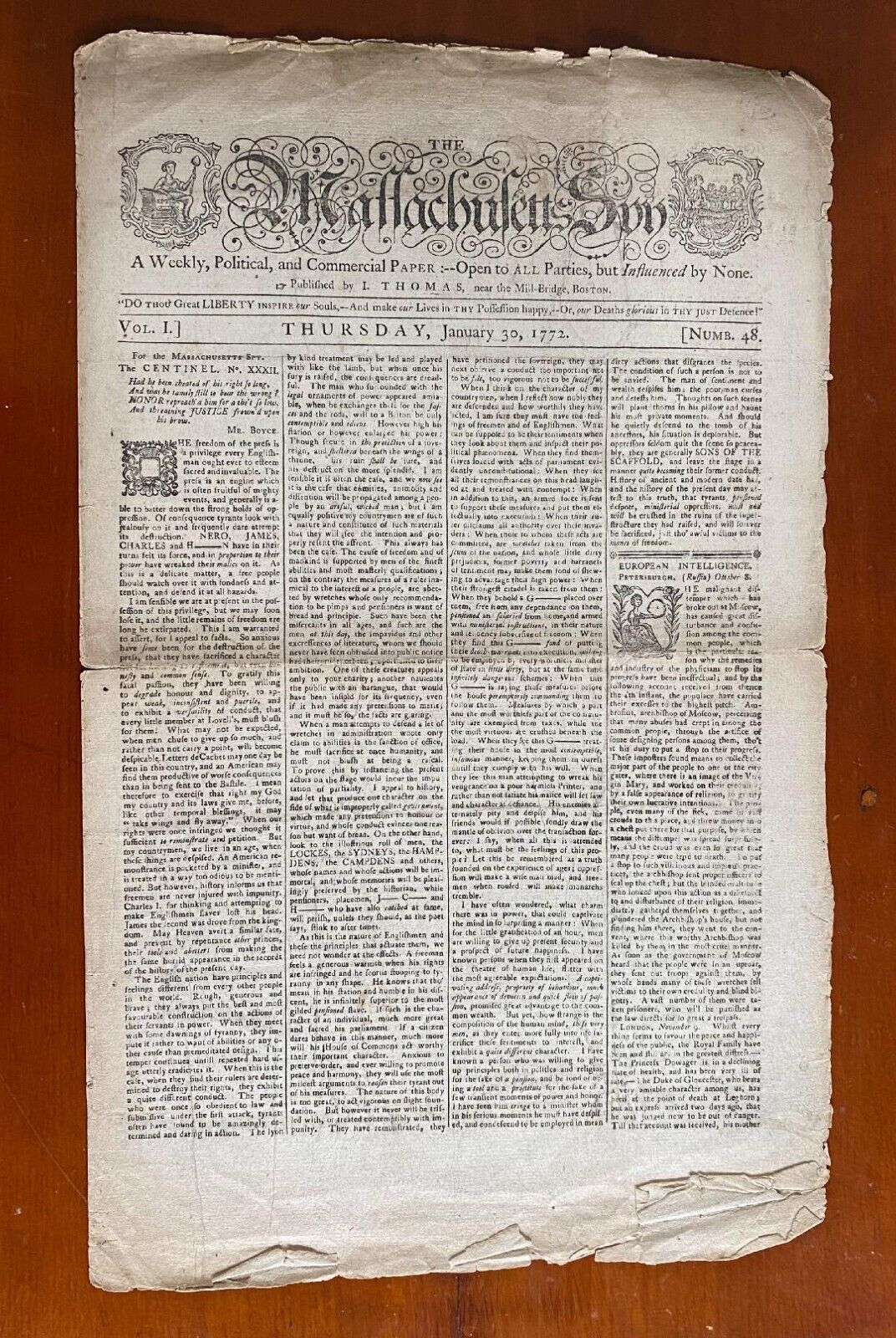
When you click on links to various merchants on this site and make a purchase, this can result in this site earning a commission. Affiliate programs and affiliations include, but are not limited to, the eBay Partner Network.

1772 MASSACHUSETTS SPY w/ Paul Revere Masthead, Freedom of the Press, SLAVE Sale:
$600.00
Offered here is a rare issue of The Massachusetts Spy A Weekly, Political, and Commercial Paper: -- Open to All Parties, but Influenced by None, Thursday, January 30, 1772, Vol. I..... No. 48, published by Isaiah Thomas (Worcester), 11 3/4" x 19"; 4pp. This important colonial newspaper has fine content [local, national, international news], with a lengthy p.1 discussion of "Freedom of the Press," and on p. 3 an ad stating: "To be SOLD A LIKELY Negro Girl, about 19 years of age, who has had the small pox, and can do any kind of houshold work in town or country. Enquire of the Printer." In addition, this newspaper bears the masthead designed by Paul Revere [he actually produced three distinct mastheads for the paper, this being his first]. Disbound, fold (wear, small breaks), edge wear (small tears/ chipping in the ample margins), light toning-- overall very good. All colonial newspapers appeared weekly and were sold by subscriptions. While most colonial newspapers had circulations of between 500 and 1,000, the Massachusetts Spy had a circulation of 3,500 from subscribers throughout the thirteen colonies making it the most popular American newspaper at the time. Designed specifically for the middling or middle class of craftsmen, the paper was founded in 1770 by Isaiah Thomas and his former master Zechariah Fowle, later Thomas would buy out Fowle and publish the Spy on his own. While Thomas initially tried to make the Spy an impartial voice, he soon found it impossible to do so in Boston the epicenter of the growing imperial crisis. Thomas’s strident Whig position is evident in his writing and in his text above the masthead: Americans! –Liberty or Death! –Join or Die! In 1754, six-year-old Isaiah Thomas was apprenticed to Boston printer Zechariah Fowle when Zechariah’s brother Daniel was unjustly arrested and held for several days for printing a satirical pamphlet that criticized the Province of Massachusetts Bay’s Great and General Court. “Living in the family of Daniel Fowle’s brother, I early became minutely acquainted with the whole transaction, and deep impressions were then made upon my mind in favor of the liberty of the press,” he later wrote in the History of Printing in America, published in 1810. Due to this incident, Daniel moved to New Hampshire and in 1756 started the New Hampshire Gazette, with Zechariah taking over his Boston printing establishment. Isaiah eventually became Zechariah’s partner, and on July 17, 1770, they began publishing the Massachusetts Spy, which would become one of the most important newspapers of the American Revolution. The paper—named after earlier English papers dubbed “spye”—initially started with a thrice weekly schedule to appeal to the working class, who it was thought might prefer smaller but more frequent doses of news, and it was available on days when no other Boston paper was being published. However, publication moved to twice weekly after Fowle dropped out of the enterprise at the end of October. After a break at the six-month mark in February, the new weekly Thursday schedule commenced with a decorative masthead and the subtitle, “open to all parties, but influenced by none” (March 7, 1771).That same issue also featured articles on the one-year anniversary of the Boston Massacre, and the next issue displayed an image of the Goddess of Liberty, revealing the paper’s true leaning. The November 22, 1771 issue continued to profess neutrality, yet included the lines from Joseph Addison’s Cato, “Do thou great Liberty inspire our Souls,—And make our lives in thy Possession happy,—Or, our Deaths glorious in thy just Defence.” The July 7, 1774 issue of the Spy finally dropped the veneer of impartiality toward the rising tensions with Great Britain, featuring Paul Revere’s design of a disjointed snake representing the separate colonies and adding the exhortation “Join or die.” The Sons of Liberty were said to meet in the office of the Spy, and it became the most popular newspaper, surpassing its rival patriot paper the Boston Gazette, with subscriptions throughout the colonies. Governor Thomas Hutchinson attempted to prosecute Thomas in 1771, but a grand jury failed to find cause for indictment. Thomas’s rhetorical combat promoted the cause of freedom, but with every article critical of the British or their loyalists, threats to his person and property increased. He was on a list of twelve people—including John Hancock and Samuel Adams—who were to be summarily executed when captured. Due to the escalating pressure, the April 6, 1775 issue was the last published in Boston as Thomas was induced to remove his press and types in a nighttime escape. The next Wednesday morning issue of May 3, 1775 was the first newspaper published in the central Massachusetts town of Worcester. In that issue was printed his most famous article, the coverage of the Battles of Lexington and Concord, which was the most influential and widely copied version due to it clearly being a detailed eye-witness account. This article has been deemed the first instance of American war correspondence. When the British evacuated Boston in March 1776, Thomas considered moving the paper back to Boston, but ultimately remained in Worcester. On July 14, 1776, Thomas is said to have held the first public reading of the Declaration of Independence in New England. He then leased the paper out for several years until he resumed control in 1778. Thomas went on to become the foremost printer and publisher in America, operating over twenty bookstores in the greater Boston area, and he founded the American Antiquarian Society in 1812. After settling in Worcester, the paper was suspended from 1786 to 1788 due to the stamp tax, and the Worcester Magazine replaced it. In 1799, Thomas started publishing it with his son, Isaiah Thomas Jr., who took over in 1801. The paper continued for the next century with a succession of editors, locations, name changes and owners as its fortunes gradually declined, especially after the Worcester Daily Spy began in 1845. The last weekly edition was printed on December 31, 1897. ISAIAH THOMAS (1749-1831) was the foremost printer of the generation that came of age during the American Revolution. He was instrumental in starting the Revolution and once the new nation was founded he became its principal and most successful printer, publisher, and bookseller. His success made him one of the wealthiest men in the country. Thomas’s career is made even more remarkable by the fact that he was entirely a self-made man. In 1812, Thomas founded the American Antiquarian Society, designed to be a learned society and national institution dedicated to preserving the written record of the United States. Thomas’s own collection of books, newspapers, and ephemera formed the basis of this collection, and his philosophy of collecting continues to shape the way Americans understand the past today. ISAIAH THOMAS, JR. (1773-1819) was born in Boston, the only son of Isaiah Thomas, Sr., Isaiah Thomas, Jr. was one of the incorporators of the American Antiquarian Society in 1812. He also served as the Society's treasurer from 1813 until his death in 1819. He was remembered as 'a man of large intelligence and fond of books, wrote with ease and rapidity, of excellent conversational powers, fond of and devoted to his home and family.' Thomas was taught the business of printing by his father and started his career as a bookseller in 1792 at the age of nineteen. Five years later he married Mary Weld, the daughter of a wealthy Boston merchant. In 1799 he became the co-publisher of the Massachusetts Spy, sharing the masthead with his father until 1801, when he was made the sole publisher and editor. Thomas bought out his father's large printing, papermaking and publishing business in 1802 when Isaiah Thomas, Sr., retired. In 1810 the younger Thomas moved to Boston, and continued to issue the Spy and the family's almanac, as well as to print books such as Bernhard Faust's A New Guide to Health (1810) and Charles Robbins's The Drum & Fife Instructor (1812). Thomas's business interests were adversely affected by the War of 1812. He sold the Spy in that year and tried to expand his bookselling business by opening shops in Connecticut, Maine, and Maryland. He continued to issue a variety of almanacs and books. Copies of many of his publications are preserved in the imprint collection of the American Antiquarian Society. Thomas died in Boston in the summer of 1819 following an accident. His father noted in his diary on June 25th, 'My son died, aged 45 years, occasioned by the wounds he received by a Fall the Evening before.' Two days later, Isaiah Thomas, Jr., who left a widow and nine children, was buried in Worcester. His father wrote, 'My son's remains were deposited in my tomb in the North burying ground this morning at 8 o'clock. Prayers by Dr. Freeman at the house of Eben T. Andrews - from whence the corpse was carried to the burying ground.' LEONARD WORCESTER (1767-1846) served an apprenticeship in the printing office of Isaiah Thomas, Esq., Worcester, Mass., after which he was for several years editor, printer and publisher of the "Massachusetts Spy". He was chosen a deacon of the First Church, Worcester, in 1795, licensed to preach Mar. 12, 1799, ordained pastor of the Cong. Church, Peacham, Vt., Oct. 30, 1799, discharged the duties of his office until 1837, when he left Peacham on account of ill health and resided with his sons in Littleton, N.H., and St. Johnsbury, Vt., until his decease at the latter place. His remains were removed to Peacham for interment. Four of his sons entered the ministry, the ordination of each being preached by their father. He received the degree A.M. from Middlebury, 1804, and from Dartmouth in 1827. He printed numerous sermons and controversial pamphlets.


1772 MASSACHUSETTS SPY w/ Paul Revere Masthead, Freedom of the Press, SLAVE Sale $600.00
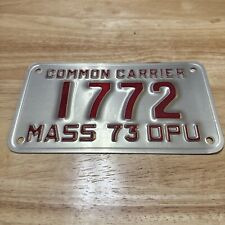
Massachusetts 1973 COMMON CARRIER DPU License Plate & PLATE Number 1772 Unused $29.95
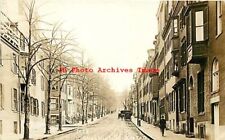
MA, Boston, Massachusetts, RPPC, Chestnut Street, Photo No 1772 $14.99
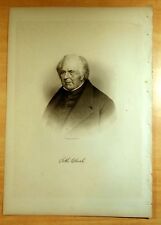
SETH CLARK Salisbury (1772) Massachusetts MA Steel Engraving Portrait 1888 Print $21.99
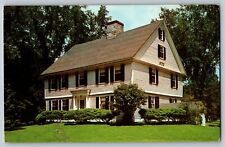
Williamstown Massachusetts Nehemiah Smedley House MA 1772 Vintage Postcard A33 $4.69
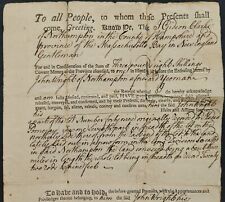
1772 antique COLONIAL DEED northampton province ma bay gideon CLARK john WRIGHT $295.00
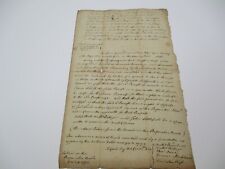
ANTIQUE EARLY AMERICAN WELLS MASSACHUSETTS DOCUMENT SIGNED 1772 ACRES OF LAND $500.00
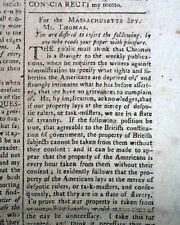
Famed PAUL REVERE MASTHEAD Engraving & Battle of Alamance 1772 Boston Newspaper $870.00
|